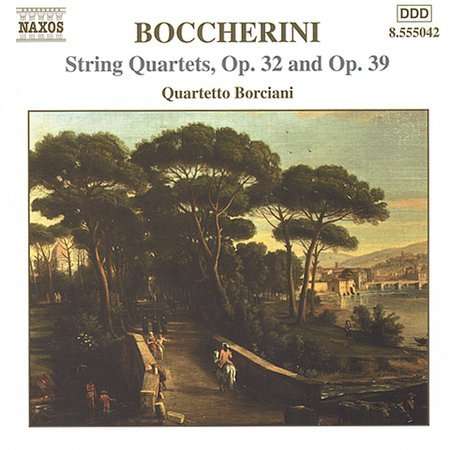Luigi Boccherini: Streichquartette op.32 Nr.1 & 2;op.39 auf CD
Streichquartette op.32 Nr.1 & 2;op.39
Herkömmliche CD, die mit allen CD-Playern und Computerlaufwerken, aber auch mit den meisten SACD- oder Multiplayern abspielbar ist.
Lassen Sie sich über unseren eCourier benachrichtigen, falls das Produkt bestellt werden kann.
- Künstler:
- Quartetto Borciani
- Label:
- Naxos
- Aufnahmejahr ca.:
- 2000
- UPC/EAN:
- 0747313504220
- Erscheinungstermin:
- 3.9.2001
Ähnliche Artikel
Die sechs Quartette, die 1780 geschrieben und von Boccherini als Opus 32 und Opera grande aufgelistet wurden, wurden um 1782 von Artaria in Wien als Opus 33 herausgegeben und, wie der größte Teil von Boccherinis Werk, in Paris veröffentlicht, wo es 1785 erschien. Das Streichquartett in Es-Dur, Opus 32, Nr. 1, beginnt mit einem anmutigen Satz, charakteristisch gekennzeichnet als Allegretto lentarello e affettuoso, und, wie so oft, unter Verwendung kurzer, sich wiederholender Figuren. Es war in der Tat dieses letzte Merkmal von Boccherinis Werk, das zunächst zu einem Bruch mit dem Prinzen von Asturien und zur Ablehnung Boccherinis durch den spanischen Hof geführt hatte. Der Fürst hatte, wie es scheint, an einer sich wiederholenden Figur, do-si, in der ersten Violinstimme, die er spielte, Anstoß genommen. Seiner Verurteilung des Werkes als Müll begegnete der Komponist mit der Antwort, dass nur musikalische Ignoranz die neuartige Wirkung der Harmonien, die die Wiederholung begleiteten, nicht erkennen ließ. Auf den dreiteiligen Sonatensatz in Sonatenform folgt ein Menuett von besonderem Reiz, mit einem Trio in kontrastierter Tonart. Der langsame Satz in c-Moll führt ein Element dramatischer Spannung ein, das sich im finalen Allegro vivace assai sofort auflöst.
Der zweite Stück des Zyklus, das Streichquartett in e-Moll, Opus 32, Nr. 2, beginnt mit einem Satz mit der Bezeichnung Largo sostenuto, voll von der dunkleren Stimmung, die durch die Wahl der Tonart suggeriert wird, modifiziert durch sekundäres Material, mit dem notwendigen Wechsel der Tonart. Boccherini kombiniert den langsamen Satz mit dem e-Dur-Menuett, auf das, selbst bei seiner Wiederholung, ein Moll-Larghetto folgt. Das Quartett endet mit einem E-Dur-Rondo, das in seinen Episoden einen Kontrast bildet, eine in der Art einer Musette und eine andere mit höheren Anforderungen an das Cello.
Product Information
The six quartets written in 1780 and listed by Boccherini as Opus 32 and opera grande were published in Vienna by Artaria in about 1782 as Opus 33, and published, as most of Boccherini’s work was, in Paris, where it appeared in 1785. The String Quartet in E flat major, Opus 32, No. 1, opens with a graceful movement, characteristically marked Allegretto lentarello e affettuoso, and, as so often, making use of short repeated figures. It was, indeed, this last feature of Boccherini’s work that had initially caused a breach with the Prince of Asturias and the rejection of Boccherini by the Spanish court. The Prince had taken exception, it seems, to a repeated figure, do-si, in the first violin part that he was playing. His condemnation of the work as rubbish was met by the composer with the response that it was only musical ignorance that brought no recognition of the novel effects of the harmonies that accompanied the repetition. The tripartite sonata-form first movement is followed by a Minuet of particular charm, with a Trio of contrasted key. The C minor slow movement introduces an element of dramatic tension, dispelled at once in the final Allegro vivace assai.
The second of the set, the String Quartet in E minor, Opus 32, No. 2, starts with a movement marked Largo sostenuto, replete with the darker mood suggested by the choice of key, modified in secondary material, with the necessary change of key. Boccherini combines the slow movement with the E major Minuet, which is followed, even at its repetition, by a minor key Larghetto. The quartet ends with an E major rondo which provides contrast in its episodes, one in the manner of a musette and another with greater demands on the cello.
Disk 1 von 1 (CD)
-
1 String Quartet in A major, Op. 39, G. 213: I. Allegro moderato
-
2 String Quartet in A major, Op. 39, G. 213: II. Minuetto: Allegro
-
3 String Quartet In A Major, Op. 39, G. 213: Iii. Grave
-
4 String Quartet in A major, Op. 39, G. 213: IV. Allegro giusto
-
5 String Quartet in E flat major, Op. 32, No. 1, G. 201: I. Allegretto lentarello e affettuoso
-
6 String Quartet in E flat major, Op. 32, No. 1, G. 201: II. Minuetto
-
7 String Quartet In E Flat Major, Op. 32, No. 1, G. 201: Iii. Grave
-
8 String Quartet in E flat major, Op. 32, No. 1, G. 201: IV. Allegro vivace assai
-
9 String Quartet in E minor, Op. 32, No. 2, G. 202: I. Largo sostenuto
-
10 String Quartet in E minor, Op. 32, No. 2, G. 202: II. Minuetto- Larghetto - Minuetto
-
11 String Quartet In E Minor, Op. 32, No. 2, G. 202: Iii. Rondeau Comodo Assai










